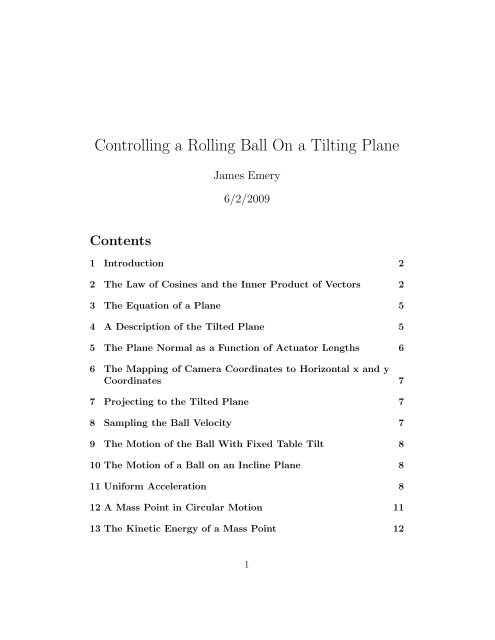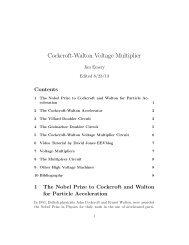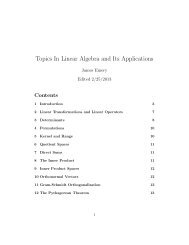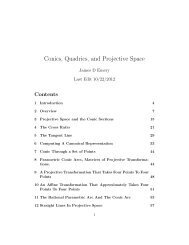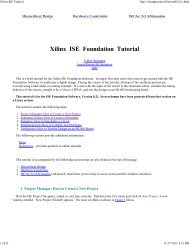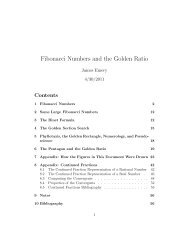Controlling a Rolling Ball On a Tilting Plane - STEM2
Controlling a Rolling Ball On a Tilting Plane - STEM2
Controlling a Rolling Ball On a Tilting Plane - STEM2
You also want an ePaper? Increase the reach of your titles
YUMPU automatically turns print PDFs into web optimized ePapers that Google loves.
<strong>Controlling</strong> a <strong>Rolling</strong> <strong>Ball</strong> <strong>On</strong> a <strong>Tilting</strong> <strong>Plane</strong><br />
James Emery<br />
6/2/2009<br />
Contents<br />
1 Introduction 2<br />
2 The Law of Cosines and the Inner Product of Vectors 2<br />
3 The Equation of a <strong>Plane</strong> 5<br />
4 A Description of the Tilted <strong>Plane</strong> 5<br />
5 The <strong>Plane</strong> Normal as a Function of Actuator Lengths 6<br />
6 The Mapping of Camera Coordinates to Horizontal x and y<br />
Coordinates 7<br />
7 Projecting to the Tilted <strong>Plane</strong> 7<br />
8 Sampling the <strong>Ball</strong> Velocity 7<br />
9 The Motion of the <strong>Ball</strong> With Fixed Table Tilt 8<br />
10 The Motion of a <strong>Ball</strong> on an Incline <strong>Plane</strong> 8<br />
11 Uniform Acceleration 8<br />
12 A Mass Point in Circular Motion 11<br />
13 The Kinetic Energy of a Mass Point 12<br />
1
14 The Simple Rotation of a Rigid Body 13<br />
15 The Acceleration of a Body <strong>Rolling</strong> Down an Incline <strong>Plane</strong> 13<br />
16 Bringing the <strong>Ball</strong> to Rest in a Given Distance by <strong>Tilting</strong> the<br />
<strong>Plane</strong>. 15<br />
17 Given a <strong>Ball</strong> at Rest at Point P, Compute the Tilt Motion<br />
toBringIttoRestatPointQ 15<br />
18 Making a <strong>Ball</strong> Follow a Specified Path 15<br />
19 Optimization 15<br />
20 Practical Considerations: Defining a Path for the <strong>Ball</strong> to<br />
Follow 16<br />
21 Bibliography 16<br />
1 Introduction<br />
We are given a ball on a tilted table moving with a specified velocity. We<br />
are to change the velocity and position in a specified way by changing the<br />
tilt angles of the table. If you know about the law of cosines and the inner<br />
(dot product) of vectors, you may skip the next two sections.<br />
2 The Law of Cosines and the Inner Product<br />
of Vectors<br />
We shall prove the law of cosines. Suppose we have three points<br />
p 0 =(0, 0),p 1 =(b, 0),p 2 =(x, y) =(a cos(θ),asin(θ)).<br />
These points form a triangle with sides p 0 p 2 ,p 0 p 1 ,p 2 p 1 . These sides have<br />
lengths a, b, c. The angle between side p 0 p 1 and side p 0 p 2 is θ. Wehave<br />
c 2 =(x − b) 2 + y 2<br />
=(x − b) 2 + a 2 − x 2<br />
2
= x 2 − 2xb + b 2 + a 2 − x 2<br />
= a 2 + b 2 − 2xb = a 2 + b 2 − 2ab cos(θ).<br />
Thus we have the law of cosines, namely the square of the side opposite an<br />
angle of a triangle, is equal to the sum of the squares of the adjacent sides,<br />
minus two times the product of the sides and the cosine of the angle. That<br />
is,<br />
c 2 = a 2 + b 2 − 2ab cos(θ).<br />
The inner product (dot product) of two vectors, A and B, is defined as<br />
A · B = a 1 b 1 + a 2 b 2 + a 3 b 3 .<br />
Then the dot product of a vector with itself is the square of its length. That<br />
is,<br />
A · A = a 1 a 1 + a 2 a 2 + a 3 a 3 = ‖A‖ 2 .<br />
Let<br />
Then<br />
From which it follows that<br />
C = B − A.<br />
‖C‖ 2 =(B − A) · (B − A)<br />
= B · B − B · A − A · B + A · A<br />
= ‖B‖ 2 − 2A · B + ‖A‖ 2 .<br />
2A · B = ‖A‖ + ‖B‖ 2 −‖C‖ 2 .<br />
But the right hand side is, by the law of cosines,<br />
2‖A‖‖B‖ cos(θ),<br />
where θ is the angle between vectors A and B. Hence<br />
A · B = ‖A‖‖B‖ cos(θ).<br />
Thus if the the dot product is zero, then the cosine is zero, and so the angle<br />
between the vectors is plus or minus π/2, and the vectors are perpendicular.<br />
3
(x,y)<br />
a<br />
θ<br />
c<br />
(0,0) b<br />
(b,0)<br />
Figure 1: Derivation of the law of cosines. x =cos(θ), y =sin(θ). Computing<br />
c 2 , we find that c 2 = a 2 + b 2 − 2ab cos(θ).<br />
4
3 The Equation of a <strong>Plane</strong><br />
Suppose a plane has a unit normal n. Let a point on the plane be given by<br />
a vector p. Then<br />
n · p = ‖p‖ cos(θ),<br />
where θ is the angle between n and p. This is the perpendicular distance d<br />
from the origin to the plane. Therefore the equation of the plane is<br />
n · p = d,<br />
where<br />
that is<br />
p =(x, y, z).<br />
n 1 x + n 2 y + n 3 z = d.<br />
4 A Description of the Tilted <strong>Plane</strong><br />
We consider a table elevated from the floor by a distance h. That is the pivot<br />
point on the table plane is located at a distance h. This pivot point in the<br />
center of the table is supported by a column of length h. We assume here<br />
for simplicity that the pivot point is on the surface of the table, neglecting<br />
certain offsets that will be needed later. The table is tilted by two actuators.<br />
We take our coordinate system so that the xy plane is the floor, and the<br />
origin is directly below the table pivot point. An x actuator is a line segment<br />
of variable length that always lies in the y = 0 plane. It is connected to the<br />
center supporting column at a point a distance c x from the pivot point in<br />
the table plane. It is connected to the table plane at a point that is at a<br />
distance t x from the pivot point. Similarly, a y actuator always lies in the<br />
x = 0 plane. It is connected to the center supporting column at a point a<br />
distance c y from the pivot point in the table plane. It is connected to the<br />
table plane at a point that is at a distance t y from the pivot point. Let the x<br />
actuator have variable length α, andthey actuator have variable length β.<br />
5
5 The <strong>Plane</strong> Normal as a Function of Actuator<br />
Lengths<br />
The tilt of the table is controlled by two actuator lengths, as specified in the<br />
previous section. Let us first consider the x actuator with length α.<br />
We want to compute a vector u 1 that lies in the intersection of the y =0<br />
plane and the table plane. This vector is given by<br />
u 1 =(cos(θ x ), 0,sin(θ x )),<br />
where θ x is the angle between a line that is the intersection of the table plane<br />
with the y = 0 plane, and the horizontal plane. This is<br />
θ x = φ x − π/2,<br />
where angle φ x is given by the law of Cosines<br />
cos(φ x )= c2 x + t 2 x − α 2<br />
.<br />
2c x<br />
Similarly, we compute a vector u 2 that lies in the intersection of the x =0<br />
plane and the table plane. This vector is given by<br />
u 2 =(0, cos(θ y ), sin(θ y )),<br />
where θ y is the angle between a line that is the intersection of the table plane<br />
with the x = 0 plane, and the horizontal plane. This is<br />
θ y = φ y − π/2,<br />
where angle φ y is given by the law of Cosines<br />
cos(φ y )= c2 y + t2 y − β2<br />
.<br />
2c y<br />
Now the plane normal is<br />
n = u 1 × u 2 .<br />
The equation of our table plane then is<br />
n · p = h,<br />
where h is the vertical distance from the floor to the table pivot point. We<br />
will use this equation to compute the z coordinate of the center of the ball<br />
rolling on the tilted plane, where the x and y coordinates are specified by the<br />
camera image.<br />
6
6 The Mapping of Camera Coordinates to<br />
HorizontalxandyCoordinates<br />
This is the problem of aerial photography in miniature. But let us assume<br />
that there are two functions f x and f y that map the video pixel coordinates<br />
(i, j) tox and y coordinates. That is<br />
x = f x (i, j),<br />
and<br />
y = f y (i, j).<br />
Perhaps these are given by OpenCV functions. For more precision we<br />
might have to consider the optics and focal properties of the camera lenses.<br />
Now to compute the z coordinate we need the equation of the table plane<br />
for a given tilt.<br />
7 Projecting to the Tilted <strong>Plane</strong><br />
So in the previous section we assume we have the x and y coordinates computed<br />
from the camera image as<br />
x = f x (i, j),<br />
and<br />
y = f y (i, j).<br />
Now we need the z coordinate of the point on the plane. We find z using the<br />
equation of the plane found from the actuator lengths which define the plane<br />
normal n. The equation of the plane is<br />
xn x + yn y + zn z = h,<br />
from which we have<br />
z = h − (xn x + yn y )<br />
n z<br />
.<br />
8 Sampling the <strong>Ball</strong> Velocity<br />
We compute the ball velocity by getting two ball positions in a small time<br />
interval ∆t.<br />
v = p 2 − p 1<br />
∆t<br />
7
9 The Motion of the <strong>Ball</strong> With Fixed Table<br />
Tilt<br />
Suppose we measure the position and velocity of the ball using the camera.<br />
We wish to compute the trajectory of the ball on the plane with fixed actuator<br />
lengths α and β. So suppose the ball is at position p with velocity v. First<br />
we intersect the table plane with the horizontal plane getting a line direction<br />
unit vector w 1 . Then we compute a perpendicular unit vector w 2 .Weresolve<br />
the velocity vector into components in these directions, say<br />
v = v 1 w 1 + v 2 w 2<br />
So the motion is constant in the direction of w 1 , and in the direction of w 2<br />
it is pure rolling down an incline plane. So in the next section we derive the<br />
motion of the ball down an incline plane.<br />
10 The Motion of a <strong>Ball</strong> on an Incline <strong>Plane</strong><br />
To compute the motion of a ball rolling down an incline plane we need to<br />
derive some properties of uniform linear and also circular motion since the<br />
ball is rolling. It turns out that we need to consider the rotational moment<br />
of inertia of the ball. The next few sections treat this material.<br />
11 Uniform Acceleration<br />
Suppose a mass point undergoes uniform acceleration a. Then<br />
a = d2 s<br />
dt , 2<br />
where s is the location coordinate of the point.<br />
becomes<br />
∫<br />
v = adt = v 0 + at<br />
Integrating, the velocity<br />
where v 0 is the initial velocity. Integrating again, the position is<br />
∫<br />
s = vdt = s 0 + v 0 t + a t2 2 ,<br />
8
where s 0 is the initial position. The change in kinetic energy is<br />
m( v2<br />
2 − v2 0<br />
2 )=f(s − s 0)=ma(s − s 0 ),<br />
where f is a constant force of acceleration. Dividing by m/2 weget<br />
v 2 − v 2 0 =2a(s − s 0).<br />
The velocity increases linearly with the time, so the average velocity multiplied<br />
by the time is the distance traveled<br />
The four equations<br />
v + v 0<br />
2<br />
t = v 0 + at + v 0<br />
t<br />
2<br />
=(v 0 + at<br />
2 )t<br />
= v 0 t + at2<br />
2<br />
=(s − s 0 ).<br />
v = v 0 + at,<br />
s = s 0 + v 0 t + a t2 2 ,<br />
v 2 − v 2 0 =2a(s − s 0),<br />
and<br />
v + v 0<br />
t =(s − s 0 ),<br />
2<br />
usually suffice to solve problems of this type.<br />
Example 1. Suppose a ball is rolled off of the edge of a table top. Suppose<br />
the table is at height height h and the ball lands on the floor at a distance<br />
s from a point on the floor below the table edge. What was the horizontal<br />
velocity of the ball as it left the table edge<br />
Solution The ball is accelerated by the acceleration of gravity g downward.<br />
The initial vertical velocity is zero, and the initial vertical position is zero.<br />
So using the second formula<br />
h = g t2 2 ,<br />
9
from which we find the time at which the ball hits the floor to be<br />
√<br />
t = 2h/g.<br />
Then again from the first equation with the horizontal acceleration a =0,<br />
we have<br />
v 0 t = s.<br />
So we find the initial horizontal velocity to be<br />
v 0 = s √ g<br />
t = s 2h .<br />
In a real experiment let a be the distance up a ramp, so that the ball<br />
starting at a gains velocity v, in rolling down the ramp. Let h =0.9 meters.<br />
We measure the following values and compute v.<br />
a s v<br />
10cm .48m 1.11m/s<br />
20 .68 1.59<br />
30 .79 1.84<br />
40 .89 2.08<br />
50 1.08 2.52<br />
60 1.13 2.63<br />
70 1.18 2.77<br />
80 1.29 3.01<br />
Example 2. Suppose a stone is dropped from a one hundred meter tall<br />
bridge. What is the velocity of the stone as it hits the water, neglecting air<br />
resistance<br />
Solution The acceleration of gravity is g =9.81 meters per second squared.<br />
Then from the third equation<br />
v =<br />
v 2 =2gs,<br />
√ √<br />
2gs = 2(100)(9.81) = 44.29<br />
meters per second, or 159.5 killometers per hour.<br />
10
12 A Mass Point in Circular Motion<br />
Let a mass point point be specified in polar coordinates (θ, r). Let the point<br />
be constrained to lie on a circle of radius r. Let the polar coordinate unit<br />
vectors be<br />
u r =cos(θ)i +sin(θ)j,<br />
u θ = − sin(θ)i +cos(θ)j.<br />
The first vector is perpendicular to the circle and the second is tangent to it.<br />
Let the position vector of the point be<br />
The velocity is<br />
p = ru r .<br />
v = dp<br />
dt = dr<br />
dt u r + r du r<br />
dt = r du r<br />
dt ,<br />
because here r is constant. We have<br />
du r<br />
dt = du r dθ<br />
dθ dt<br />
dθ<br />
= u θ<br />
dt .<br />
So<br />
v = r dθ<br />
dt u θ = rωu θ ,<br />
where ω is the angular velocity. The acceleration is<br />
a = dv<br />
dt = r dω<br />
dt u θ + rω du θ<br />
dt<br />
= r dω<br />
dt u θ − rω 2 u r<br />
= r dω<br />
dt u θ − v2<br />
r u r,<br />
where dω/dt is the angular acceleration, and v = rω is the tangential velocity.<br />
If the angular acceleration is zero then v 2 /r is the magnitude of the centrepital<br />
acceleration directed toward the center of the circle.<br />
11
13 The Kinetic Energy of a Mass Point<br />
Letamasspointofmassm be accelerated from an initial velocity 0 to a<br />
velocity v by a force f through a distance s. The work done and thus the<br />
kinetic energy of the mass point is<br />
∫<br />
∫<br />
fds =<br />
m dv<br />
dt ds<br />
∫<br />
= m ds<br />
dt dv<br />
∫<br />
= mvdv<br />
= m v2<br />
2 .<br />
The kinetic energy of a rigid body of mass M moving with linear velocity v<br />
is the sum of the kinetic energies of its mass points,<br />
M v2<br />
2 .<br />
If a mass point is revolving uniformly with angular velocity ω in a circle of<br />
radius r, then its kinetic energy is<br />
m v2<br />
2 = ω 2<br />
mr2 2 .<br />
Themomentofinertiaofsuchamasspointis<br />
I = mr 2 ,<br />
hence its kinetic energy is<br />
I ω2<br />
2 .<br />
It follows that a body rotating about a fixed point with moment of inertia I<br />
has a kinetic energy of rotation<br />
I ω2<br />
2 .<br />
12
14 The Simple Rotation of a Rigid Body<br />
Although the general motion of a rigid body is rather complicated, the case<br />
of rotation about a fixed axis is simple, so we shall derive the needed formulas<br />
here.<br />
Suppose a mass point, with mass m i , is constrained to move on a circle<br />
with radius r i . Suppose a force F i is applied to this point. The forces of<br />
constraint may be ignored, since they do no work. Then the work done is<br />
dW = r i dθF ti = dθτ i ,<br />
where F ti is the tangential component of the force and τ i is the torque. Then<br />
the rate of doing work is<br />
dW<br />
= ωτ i .<br />
dt<br />
This is equal to the change in kinetic energy of the particle<br />
ωτ i = d((1/2)r2 i ω 2 m i )<br />
dt<br />
= ri 2 m dω<br />
i<br />
dt ω.<br />
Thus<br />
τ i = ri 2 m dω<br />
i<br />
dt .<br />
Summing over all particles in the rotating rigid body, we get<br />
τ = ∑ τ i =( ∑ ri 2 m i) dω<br />
dt = I dω<br />
dt ,<br />
where I is the rotational moment of inertia.<br />
15 The Acceleration of a Body <strong>Rolling</strong> Down<br />
an Incline <strong>Plane</strong><br />
Let a sphere roll down a ramp that is inclined to the horizontal by angle α.<br />
Let s be the distance from the bottom of the ramp to the contact position<br />
of the ball. Let the ball have radius r and let θ be the angle of rotation of<br />
the ball. Then let<br />
s = rθ.<br />
13
The kinetic energy of the ball is<br />
T = 1 2 Mv2 + 1 2 Iω2<br />
The potential energy is<br />
where<br />
= 1 2 Mv2 + 1 2 I(v/r)2<br />
= 1 2 (M + I/r2 )v 2<br />
V = hgM,<br />
h = s sin(θ)<br />
is the height of the ball. The Lagrangian is<br />
L = T − V = 1 2 (M + I/r2 )v 2 − s sin(θ)gM.<br />
∂L<br />
∂v =(M + I/r2 )v<br />
d ∂L<br />
dt ∂v =(M + I/r2 ) dv<br />
dt<br />
∂L<br />
∂s = − sin(θ)gM.<br />
The equation of motion is<br />
So<br />
or<br />
d ∂L<br />
dt ∂v − ∂L<br />
∂s =0<br />
(M + I/r 2 ) dv<br />
dt<br />
dv<br />
dt<br />
+sin(θ)gM =0<br />
M<br />
= −g sin(θ)<br />
M + I/r 2<br />
So the effective acceleration has been reduced by the factor<br />
M<br />
M + I/r 2<br />
14
Inthecaseofasphere<br />
so the factor becomes<br />
I = 2 5 Mr2 ,<br />
M<br />
M +(2/5)M = 5 7 .<br />
16 Bringing the <strong>Ball</strong> to Rest in a Given Distance<br />
by <strong>Tilting</strong> the <strong>Plane</strong>.<br />
Given a position p and a velocity v, compute the pure incline plane tilt that<br />
would give the ball a velocity −v after having traveled distance d. Thensince<br />
the initial velocity was v, the ball will come to a zero velocity in distance d.<br />
In practice the motion will not be exact, so the method can be iterated until<br />
the desired result is obtained.<br />
17 Given a <strong>Ball</strong> at Rest at Point P, Compute<br />
the Tilt Motion to Bring It to Rest at<br />
Point Q<br />
Let d be the distance between P and Q. Give it a reasonable starting tilt in<br />
the direction of Q, compute the time it takes to reach the halfway point. Use<br />
the technique of the previous section to bring the ball to rest in distance d/2.<br />
18 Making a <strong>Ball</strong> Follow a Specified Path<br />
Given a curved path, compute sample points along the path. Do the tilting<br />
to bring the ball to rest at each of the sample points.<br />
19 Optimization<br />
Not only must we move the ball in a specified path, we must do it in a short<br />
amount of time. So more optimal methods of moving the ball will no doubt<br />
be required.<br />
15
20 Practical Considerations: Defining a Path<br />
for the <strong>Ball</strong> to Follow<br />
Suppose we want the ball to follow a path that avoids holes in the plane.<br />
We can construct a sequence of linear paths to follow. However, if there are<br />
objects that will be bumped into, we will have to consider rebounds. Practical<br />
versions of the tilting must be constructed after behavior is determined by<br />
experiment.<br />
21 Bibliography<br />
[1]Arnold V I, Mathematical Methods of Classical Mechanics, 2nd<br />
edition, Springer-Verlag, Legendre Transformation, 1989 , (JEL).<br />
[2]Hilbert D, Courant R, Methods of Mathematical Physics, Interscience<br />
, Legendre Transformation, (JEL).<br />
[5]Hand Louis N, Finch Janet D, Analytical Mechanics, Cambridge, 1998,<br />
16


